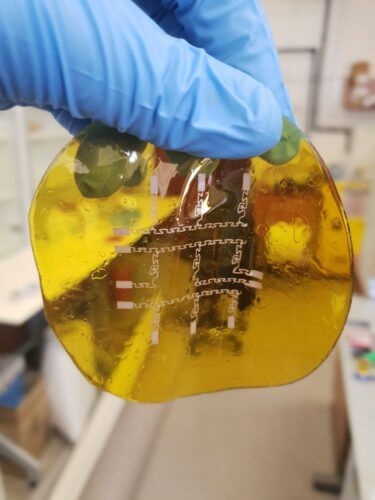The skin, which works well even in an aqueous environment, repairs itself in the event of damage and thus maintains a stable function over time

A Ph.D. student at the Technion has developed a soft, flexible and waterproof polymer, which knows how to heal itself in case of "injuries" such as scratching, cutting and twisting. The doctoral student, Mohammad Khatib, used the new polymer to develop advanced sensing platforms that monitor temperature, pressure and acidity level and may be suitable for a variety of applications in the fields of robotics, prosthetics and wearable devices. The innovative platform knows how to repair itself not only at the mechanical level - repairing the cut in the polymer sheet - but also in physical and chemical aspects such as electrical conduction and chemical sensing.
Khativ, who conducts the research at the Wolfson Faculty of Chemical Engineering under the direction of Prof. Hussam Haik, presented the innovative developments in two articles in the journals Advanced Materials and Advanced Functional Materials.
Over millions of years of evolution, the skin of mammals has developed into a sensing platform characterized on the one hand by high sensitivity to environmental stimuli and on the other hand by great resistance to hostile conditions including humidity, salinity, heat, stretching and folding. Inspired by the natural skin, many efforts are invested in the development of artificial electronic materials and devices with similar properties, and this is because of their enormous application potential in fields such as soft robotics and human-machine interfaces.
Such systems require the development of soft materials whose function is not impaired as a result of deformations and cuts. The problem is that soft materials tend to be damaged, also functionally, over time. From this comes the research motivation for the development of new materials and new systems that know how to heal themselves, just like the human skin after an injury.
Khatib's first project, presented in the journal Advanced Functional Materials, describes the design, construction and application of an elastomer - a flexible and stretchable polymer - with unique properties. The new elastomer is a very strong and flexible hydrophobic material, which can stretch to 1,000% of its original length without tearing. One of its unique properties is self-fusion - an ability that is preserved even when soaked in tap water, sea water and water with different acidity values. This elastomer has great application potential in the development of soft and dynamic electronic devices that come into contact with water. In the event that the mechanical damage to the polymer occurs when it is immersed in water, it knows how to repair itself and prevent leakage currents, i.e. loss of current from the device to the water.
Khatib took advantage of the promising properties of the new polymer for the development of an artificial electronic skin - a project he presents in the journal Advanced Materials. This structure combines many features and capabilities, including selective sensing, water resistance, self-monitoring and self-repair. The artificial skin contains a sensing array consisting of nanometer materials and selectively and simultaneously monitors various environmental variables including pressure, temperature and acidity. Finally, inspired by the healing of wounds in human skin, Khativ integrated an innovative system for autonomous self-healing into the artificial skin. This system consists of neuron-like components that monitor damage to the electronic parts of the system, and other components that accelerate self-healing in the damaged areas. This self-repair mechanism will allow smart electronic systems to self-monitor their activity and correct functional faults caused by mechanical damage.
According to Khativ, "the new sensing platform is a universal system that demonstrates stable function in a dry or aquatic environment, and it can contain additional types of chemical and physical (electrical) sensors." The two projects we published pave new ways and new strategies for the development of electronics inspired by the skin, which can be integrated into wearable devices and electronic skin devices in contexts such as advanced robots and artificial organs."
Partners in the research are laboratory director Vala Saliva, researcher Or Zohar who worked on the development of the sensors and their characterization, and Prof. Simcha Sarabnik who worked on molecular simulations that demonstrate the capabilities of the new polymer.
The research was conducted with the support of the Bill and Melinda Gates Foundation and with the help of a grant to the A-Patch project (as part of the Horizon 2020 program).
Mohammad Khativ completed a bachelor's degree in biochemical engineering at the Technion and went on to a doctorate in a special track where he specialized in the development of materials and advanced sensing devices that simulate skin. In the coming weeks, he will finish his doctorate at the Wolfson Faculty of Chemical Engineering, and intends to soon move to Stanford University for a post-doctorate.
The director of the research group Prof. Hussam Haik, an expert in sensor-based medical monitoring, is the head of the laboratory for nanomaterials-based devices in the Wolfson Faculty of Chemical Engineering, a member of the Russell Berry Institute for Nanotechnology, the senior deputy for equal opportunities and dean of certification studies at the Technion.
More of the topic in Hayadan:
- Five reasons why robots won't take over the world
- 16 research proposals were selected in the second round of the research program in personalized medicine of the National Science Foundation
- An integrated system for the early diagnosis of diseases using wearable monitoring
- A tattoo that is also a sensor

2 תגובות
Excellent, slow and steady, we will replace the experiments with the Amen!
I admit that I didn't understand or anything, but I ask:
Can the skin be used as a replacement for facial skin that has matured and developed wrinkles?